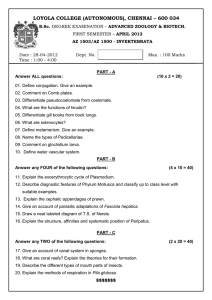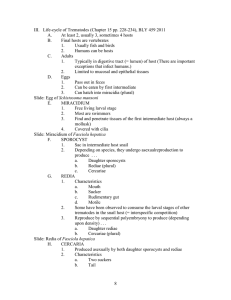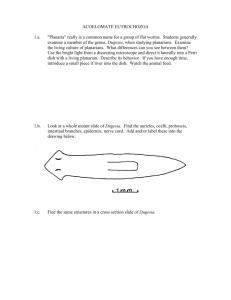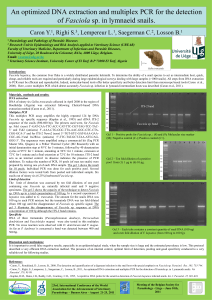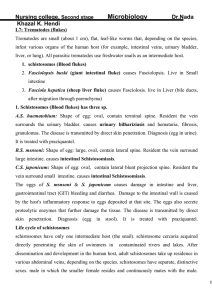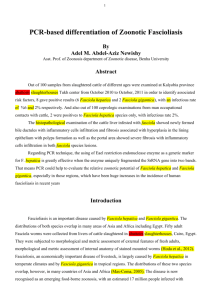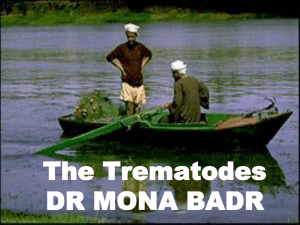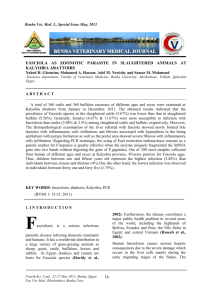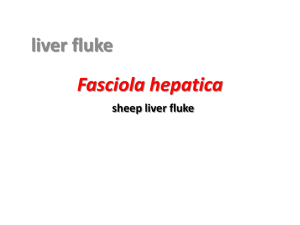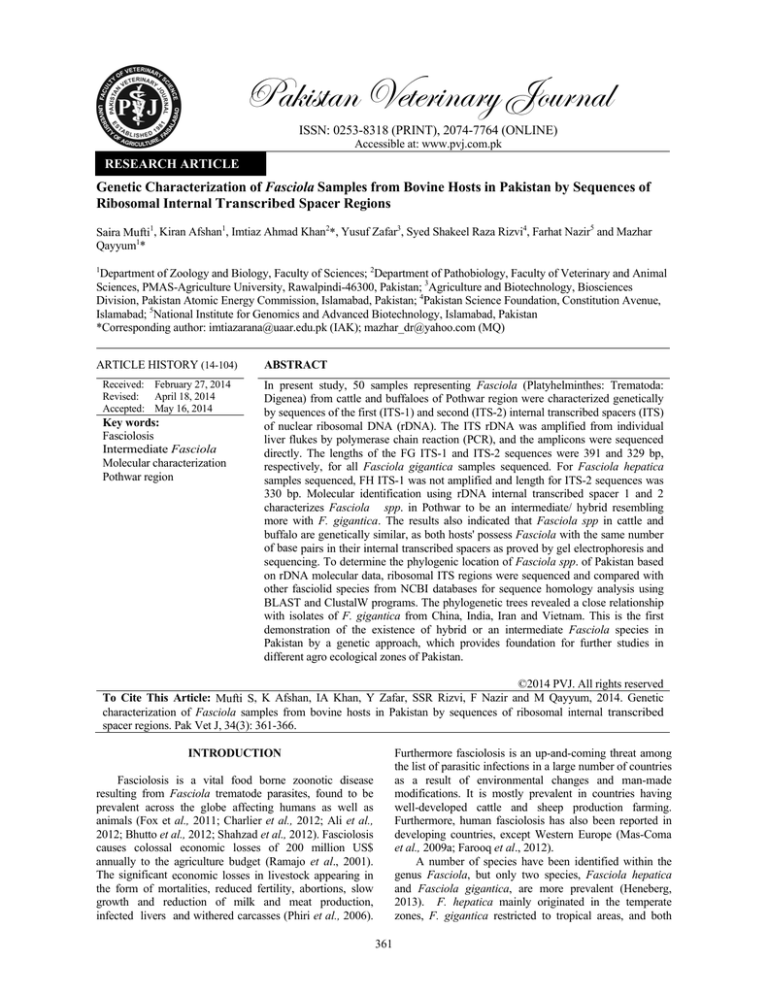
Pakistan Veterinary Journal
ISSN: 0253-8318 (PRINT), 2074-7764 (ONLINE)
Accessible at: www.pvj.com.pk
RESEARCH ARTICLE
Genetic Characterization of Fasciola Samples from Bovine Hosts in Pakistan by Sequences of
Ribosomal Internal Transcribed Spacer Regions
Saira Mufti1, Kiran Afshan1, Imtiaz Ahmad Khan2*, Yusuf Zafar3, Syed Shakeel Raza Rizvi4, Farhat Nazir5 and Mazhar
Qayyum1*
1
Department of Zoology and Biology, Faculty of Sciences; 2Department of Pathobiology, Faculty of Veterinary and Animal
Sciences, PMAS-Agriculture University, Rawalpindi-46300, Pakistan; 3Agriculture and Biotechnology, Biosciences
Division, Pakistan Atomic Energy Commission, Islamabad, Pakistan; 4Pakistan Science Foundation, Constitution Avenue,
Islamabad; 5National Institute for Genomics and Advanced Biotechnology, Islamabad, Pakistan
*Corresponding author: imtiazarana@uaar.edu.pk (IAK); mazhar_dr@yahoo.com (MQ)
ARTICLE HISTORY (14-104)
Received: February 27, 2014
Revised: April 18, 2014
Accepted: May 16, 2014
Key words:
Fasciolosis
Intermediate Fasciola
Molecular characterization
Pothwar region
ABSTRACT
In present study, 50 samples representing Fasciola (Platyhelminthes: Trematoda:
Digenea) from cattle and buffaloes of Pothwar region were characterized genetically
by sequences of the first (ITS-1) and second (ITS-2) internal transcribed spacers (ITS)
of nuclear ribosomal DNA (rDNA). The ITS rDNA was amplified from individual
liver flukes by polymerase chain reaction (PCR), and the amplicons were sequenced
directly. The lengths of the FG ITS-1 and ITS-2 sequences were 391 and 329 bp,
respectively, for all Fasciola gigantica samples sequenced. For Fasciola hepatica
samples sequenced, FH ITS-1 was not amplified and length for ITS-2 sequences was
330 bp. Molecular identification using rDNA internal transcribed spacer 1 and 2
characterizes Fasciola spp. in Pothwar to be an intermediate/ hybrid resembling
more with F. gigantica. The results also indicated that Fasciola spp in cattle and
buffalo are genetically similar, as both hosts' possess Fasciola with the same number
of base pairs in their internal transcribed spacers as proved by gel electrophoresis and
sequencing. To determine the phylogenic location of Fasciola spp. of Pakistan based
on rDNA molecular data, ribosomal ITS regions were sequenced and compared with
other fasciolid species from NCBI databases for sequence homology analysis using
BLAST and ClustalW programs. The phylogenetic trees revealed a close relationship
with isolates of F. gigantica from China, India, Iran and Vietnam. This is the first
demonstration of the existence of hybrid or an intermediate Fasciola species in
Pakistan by a genetic approach, which provides foundation for further studies in
different agro ecological zones of Pakistan.
©2014 PVJ. All rights reserved
To Cite This Article: Mufti S, K Afshan, IA Khan, Y Zafar, SSR Rizvi, F Nazir and M Qayyum, 2014. Genetic
characterization of Fasciola samples from bovine hosts in Pakistan by sequences of ribosomal internal transcribed
spacer regions. Pak Vet J, 34(3): 361-366.
Furthermore fasciolosis is an up-and-coming threat among
the list of parasitic infections in a large number of countries
as a result of environmental changes and man-made
modifications. It is mostly prevalent in countries having
well-developed cattle and sheep production farming.
Furthermore, human fasciolosis has also been reported in
developing countries, except Western Europe (Mas-Coma
et al., 2009a; Farooq et al., 2012).
A number of species have been identified within the
genus Fasciola, but only two species, Fasciola hepatica
and Fasciola gigantica, are more prevalent (Heneberg,
2013). F. hepatica mainly originated in the temperate
zones, F. gigantica restricted to tropical areas, and both
INTRODUCTION
Fasciolosis is a vital food borne zoonotic disease
resulting from Fasciola trematode parasites, found to be
prevalent across the globe affecting humans as well as
animals (Fox et al., 2011; Charlier et al., 2012; Ali et al.,
2012; Bhutto et al., 2012; Shahzad et al., 2012). Fasciolosis
causes colossal economic losses of 200 million US$
annually to the agriculture budget (Ramajo et al., 2001).
The significant economic losses in livestock appearing in
the form of mortalities, reduced fertility, abortions, slow
growth and reduction of milk and meat production,
infected livers and withered carcasses (Phiri et al., 2006).
361
362
these species overlapping in subtropical areas (Mas-Coma
et al., 2005; Mas-Coma et al., 2009b). In addition to both
these species an intermediate form has been identified from
European and Asian countries by using the first and second
internal transcribed spacers (ITS-1 and ITS-2) of ribosomal
DNA (rDNA) as genetic markers (Choe et al., 2011; Ali et
al., 2012; Farjallah et al., 2013; Phalee and Wongsawad,
2014).
Genomic studies are very useful to explore the
epidemiology, genetic variation and diagnosis of fasciolids
(Liu et al., 2014). Recent applications in molecular
biology, particularly; amplification of specific DNA
has allowed the
regions and direct sequencing
differentiation of closely related species (Chaichanasak
et al., 2012; Dar et al., 2012). Previous findings have
revealed that the sequences of ITS-1 and ITS-2 of rDNA
are dependable genetic markers. Due to its highly repeated
and conserved regions the nuclear ribosomal DNA is
especially designed for molecular studies (Chilton, 2004;
Choe et al., 2011).
Previous studies based on ITS-1 and ITS-2 sequences
of fasciolids were conducted in different Asian countries
for species differentiation (Ali et al., 2012; Phalee and
Wongsawad, 2014). However, there had been no report on
characterizing Fasciola from Pakistan using genetic
approaches. Therefore, the present study was conducted to
characterize Fasciola samples from Pothwar region of
Pakistan from bovine hosts by sequences ITS-1 and ITS-2
of rDNA because these sequences have been shown to
provide specific markers for the description of F. hepatica,
F. gigantica, and the “intermediate Fasciola” (Ali et al.,
2012).
MATERIALS AND METHODS
Source of Fasciola sample: Adult Fasciola were collected
from liver of cattle and buffaloes collected from
slaughterhouses from Pothwar region, Pakistan. Worms
were washed extensively in physiological saline, identified
morphologically as Fasciola by using existing keys
(Yamaguti, 1958). The flukes which were to be used for
genomic DNA extraction were stored in 90% ethanol at
4°C.
Extraction of genomic DNA: Genomic DNA was
extracted from 50 individual specimens and also from the
apical portion of the fluke according to the method
described by Semyenova et al. (2003), with slight
modifications. DNA samples were eluted into 50 µl H2O
and stored at -20ºC, until further use.
PCR amplification for Genetic markers (rDNA ITS-1
ITS-2): Polymerase chain reaction was used to amplify the
complete ITS-1 and ITS-2 genetic markers. Four pairs of
primers were designed two each from the known sequences
of Fasciola gigantica and Fasciola hepatica. The primers
were custom synthesized (MBI-Fermentas) using the
information in NCBI data base given in Table 1. PCR
reactions were performed using standard protocol in a
thermocycler (Applied Biosystems). Samples without
genomic DNA were included in each amplification run as
“negative” control. The DNA quality was checked on a
DNA nanophotometer (IMPLEMEN) initially and then on
Pak Vet J, 2014, 34(3): 361-366.
1% agarose gel. An aliquot (10 µl) of each amplicon was
examined in (0.5 M) TAE buffer stained with ethidium
bromide. The DNA size marker of standard 1kb was used.
PCR product purification cloning and sequencing: PCR
products of FG-ITS1, FG-ITS 2 and FH-ITS2 from the six
representative hosts were purified using QIA quick
Purification kit (QIAGEN), according to the manufacturer's
instructions. Direct sequencing of PCR products was done
using PCR primers as sequencing primers. The ITS-1,
ITS-2 PCR products were cloned in TA cloning vector
using TA cloning kit (Invitrogen, USA). The cloned
samples were sent for sequencing to Macrogen, Korea.
Sequencing was done several times in order to ensure
accuracy.
Sequence analysis
Sequence alignment: The alignments were constructed
using CLUSTALW (Thompson et al., 1994), TCoffee
(Notredame et al., 2000) and MUSCLE (Edgar, 2004). A
comparison was done between progressive alignments and
iterative alignments. The alignments considered in this
exercise were of MUSCLE which works iteratively. The
gaps between alignments and the regions which are
identical are all discarded and blocks of relevant regions are
joined together. This was done using G-blocks (Castresana,
2000; Talavera and Castresana, 2007).
Sequence comparison: Sequences obtained were analyzed
using Bio-Edit software and aligned with published
sequences ITS-1, ITS-2 rDNA belonging to Fasciola spp
acquired from the GeneBank EMBL by using accession
numbers. Only those sample sequences were taken which
were complete and were high scoring blast sequences.
Phylogenetic interference: The trees were constructed
using two different approaches. BioNJ (Gascuel, 1997)
was used to construct the tree according to neighbor
joining method. Bootstrap value of 1000 was used. Any
branch having a less bootstrap value in the result was
collapsed. The second approach used was Bayesian
methods. MRBAYES 3.0 (Ronquist and Huelsenbeck,
2003) was used for analysis of the data. MRBAYES and
BioNJ were integrated in a workflow using Phylogeny
(Dereeper et al., 2008). All the trees constructed were
rendered and visualized in TreeDyn (Chevenet et al.,
2006).
RESULTS
In current study, Fasciola samples from cattle and
buffalo from different locations in Pothwar region
(Pakistan) were compared with other Fasciola species from
ruminant and human hosts belonging to different
geographical locations. The PCR products of FG ITS-1
(391 bp) and FG ITS-2 (329 bp) were subjected to direct
sequencing and were also cloned in TA cloning vector
(MBI, Fermentas) for sequencing. The PCR products for
FH ITS-2 (330 bp) were processed similarly.
The FG ITS-1 rDNA of Pakistani Fasciola were
compared with known sequences of other Fasciola
gigantica obtained from GenBank. The BLAST hit results
are shown in Table 2 and indicated maximum
363
similarity with Fasciola, from buffalo in China, with
two nucleotide differences. A four nucleotide difference
existed with isolates from Asia (Indonesia, India, Japan,
South Korea, Thailand, Vietnam) and Africa (Egypt,
Nigeria, Kenya, Burkina Faso and Zambia). The
phylogenetic tree constructed by Bayesian method support
the blast results by showing similarity between FG ITS1
(Pakistan) and the FG ITS1 species in China, India and
South Korea (Fig. 1).
When FG ITS-2 rDNA sequences were compared with
F. gigantica species (Table 3), the results showed similarity
with two nucleotide differences (isolates from China) and
three nucleotides difference (isolates from Egypt,
Indonesia, India, Japan, Nigeria and Vietnam). A four
nucleotide difference was present in isolates from Burkina
Faso, Zambia and Kenya. A Phylogenetic tree using the
Bayesian method (Fig. 2) and Cladogram indicated that FG
ITS2 found in Pakistan is unique from the FG ITS2 found
in other locations.
ITS-1 marker for F. hepatica could not be amplified,
whereas, the ITS-2 marker was amplified successfully. The
results described that FH ITS-2 from cattle and buffalo
were found to be less similar with F. hepatica from various
hosts, but more similar with Fasciola species (Table 4).
Maximum similarity existed between Vietnam Fasciola
hepatica in humans, with only one nucleotide difference.
The other isolates showed a variable relationship with six
nucleotide difference. The same relationship is also shown
in the phylogenetic tree (Fig. 3). Phylogeny suggests that
the closest neighbours of Pakistani FH ITS2 are Vietnam
and Iran. The gel picture of Fasciola species from cattle
and buffaloes showed the same band pairs (Fig. 4 and 5).
Pak Vet J, 2014, 34(3): 361-366.
Fig. 1: Phylogenetic tree of FG ITS-1 constructed by Bayesian methods
showing similarity of FG ITS1 (Pakistan) with the FG ITS1 species in India,
South Korea, and China. Accession no. with country and Fasciola type is
also given. Fg: Fasciola gigantica, Fh: Fasciola hepatica and Fas sp: Fasciola
species/intermediate. Numbers in red on tree branches show the branch
support values in percentages.
DISCUSSION
The identification and molecular characterization of
existing Fasciola species in Pothwar region was done in
present study by comparing sequences of ITS-1 and ITS-2
rDNA of Pakistani Fasciola with Fasciola species from
other geographical locations and especially in neighboring
Asian countries. Another objective was to investigate
species of origin and its diversion or resemblance with
ancestors. Phylogenetic analysis was performed using
nuclear ITS-1, ITS-2 sequences in a number of individual
worms, from buffalo and cattle and their comparison with
available identified sequences in the NCBI data bank.
The Pakistani ITS-1 and ITS-2 sequences of
Fasciola from cattle and buffalo, when compared with
each other were exactly the same. FG ITS-1 resembled
FG ITS-1 (F. gigantica) present in China, India and Egypt.
The cladograms showed that Pakistani FG ITS-2 isolates to
had very little ancestral relationship with the other isolates,
suggesting that the isolates of FG ITS2 found in Pakistan
are different from the ones already characterized in
different regions of the world, and thus are unique these
results are supported by strong branch support values.
Whereas, the BLAST results show a resemblance of
Pakistani FG ITS-2 to be unique with resemblance to F.
gigantica isolates from China, Egypt, India, Indonesia,
Japan, Nigeria and Japan.
The FH ITS2 Bayesian tree shows Pakistani FH ITS2
to be present on the same cluster as F. gigantica from
Vietnam. The parent cluster is shared with F. gigantica
Fig. 2: Phylogenetic tree of FG ITS-2 constructed using Bayesian
methods indicates that FG ITS2 found in Pakistan is unique from the
FG ITS2 found at other places. Accession no. with country and Fasciola
type is also given. Fg: Fasciola gigantica, Fh: Fasciola hepatica and Fas sp:
Fasciola species/intermediate. Numbers in red on tree branches show the
branch support values in percentages.
Fig. 3: Phylogenetic tree of FH ITS2 constructed using Bayesian analysis
suggests that the closest neighbours of FH ITS2 in Pakistan are Vietnam
and Iran. Accession no. with country and Fasciola type is also given. Fg:
Fasciola gigantica, Fh: Fasciola hepatica and Fas sp: Fasciola
species/intermediate. Numbers in red on tree branches show the branch
support values in percentages.
364
Pak Vet J, 2014, 34(3): 361-366.
Table 1: Primers pairs used for amplification of Fasciola ITS markers with Genebank accession Numbers.
Primer Pair
FG-ITS -1 F:
GCG ACC TGA AAA TCT ACT CTT ACA CAA GCG
FG-ITS -1 R:
GAC GTA CGT ATG GTC AAA GAC CAG GTT
FG- ITS -2 F:
GCT TAT AAA CTA TCA CGA CGC CCC AC
FG-ITS -2 R:
GAA GAC AGA CCA CGA AGG GTA CCG TC
FH-ITS-1F:
CTA CTC TCA CAC AAG CGA TAC ACG
FH-ITS-1R:
GTA CGT ATG GTC AAA GAC CAG GG
FH-ITS-2 F:
GCT TAT AAA CTA TCA CGA CGC CC
FH-ITS-2 R:
GAA GAC AGA CCA CGA AGG G
Table 2: Comparison of FG ITS-1 of Fasciola spp hosted in bovines (present
study) with F. gigantica from different geographical locations. The variable
positions with the country and accession number are also specified.
Variable positions FG
ITS 1
39
43
172
383 Country
Accession No
T
T
G
T
Pakistan
Present Study
AJ628043, AJ628425,
C
T
T
T
China
AJ628426
C
C
T
C
Egypt
EF612470, EF612401
C
C
T
C
India
EF027104
C
C
T
C
Indonesia
AB207143
C
C
T
C
Vietnam
AB385613, AB385614
C
C
T
C
Japan
AB207146
C
C
T
C
Thailand
AB207144
C
C
T
C
S. Korea
AB211238
Burkina
C
C
T
C
Faso
AJ853848
C
C
T
C
Zambia
AB207142
C
C
T
C
Nigeria
AM900371
EF612472, AJ628427,
C
C
T
C
Kenya
AJ628428
Table 3: Comparison of the FG ITS-2 of Fasciola spp hosted in bovines
(present study) with F. gigantica from different geographical locations. The
variable positions along with its country and accession numbers are also
specified.
ITS 2
Variable position FG
105
301
306
323 Country
Accession No
A
G
G
A
Pakistan
Present study
EU260079, AJ557511,
G
T
G
A
China
AJ557569
DQ383512, EF612482,
G
T
T
A
Egypt
EF612483
G
T
T
A
India
EF027103
AB010977, AB207149,
G
T
T
A
Indonesia
AB260080
AB207152, AB010979,
G
T
T
A
Japan
AB207151
EU260057, EU260059,
G
T
T
A
Vietnam
EU260060
EU260072, EU260075,
G
T
T
A
EU260076
EU260078, EU260061,
G
T
T
A
EU260063
EU260070, EU260074,
G
T
T
A
EU260077
G
T
T
A
Nigeria
AM900371
Burkina
G
T
T
G
Faso
AJ853848
G
T
T
G
Kenya
EF612484
G
T
T
G
Zambia
AB010976
species from Vietnam and F. hepatica species from Iran.
Branch support values of 100 suggest significant results.
In the master cluster containing FH ITS2 from Pakistan,
Fasciola isolates from Iran, Vietnam, Spain, and Uruguay
are also grouped together. FH ITS-2 shows common roots
with FG species from many countries in this phylogenetic
analysis. Therefore, phylogeny suggested that there might
be a possible presence of hybrid species between F.
gigantica and F. hepatica in Pakistan as reported in some
other regions of the world.
GeneBank Accession No.
EF612472
EF612484
EF61246
EF612481
The isolates of F. hepatica from around the world are
not very similar to the Pakistani Fasciola, except for
the Iranian
and Vietnamese
F. hepatica.
The
Vietnamese isolate which shows a very close
resemblance, is actually a hybrid/introgressed form,
existing in humans. Le et al. (2008) showed the existence
of hybrid and/or introgressed liver flukes which possess
genetic material from both the species; this phenomenon
was observed especially in humans living in Vietnam.
Therefore it is concluded that Fasciola species inhabiting
the Pothwar region does not resemble any pure species
but is an intermediate species, more closely related to F.
gigantica as compared to F. hepatica.
A BLAST similarity search was conducted on
sequence-based identification in the databases. This
determined
several
experimental
and taxonomic
limitations. In addition to the identification of unknown
ITS sequences based on these approaches, phylogeny
studies must be performed to attain valuable results for
determining closely related species. Phylogeny supports
the BLAST results (Holder and Lewis, 2003).
Considering these findings, a phylogenetic analysis was
carried out by various distance methods and character
methods like Neighbor joining method and Bayesian
analysis. Results exhibited that topology is similar among
the trees obtained. Though both methods were used in this
study, the representation of phylogenetic trees was by
Cladograms using Bayesian method.
In the present study, buffalo and cattle have the same
base pairs and similar sequences. The primary sequence
analysis and ITS sequences comparison with bovine liver
flukes in various geographical regions indicate a high
species-specific homogeneity and a close relationship
between the Fasciola residing in Pothwar and F.
gigantica from Asia and Africa and F. hepatica from
Vietnam and Iran. The similarity of BLAST results of
Pakistani Fasciola with Fasciola of the other
geographical isolates supports the similarity to F.
gigantica but it is not a pure species. The findings of this
study are in accordance with studies conducted in
Japan, Korea, China, Iran, Vietnam and Egypt indicating
that an ‘intermediate’ Fasciola species exists, which is
most likely a hybrid of the two species, as both FG ITS-2
and FH ITS-2 were amplified easily reconfirming that the
former is a better marker for species identification
(Periago et al., 2006; Le et al., 2008) and that this
region is highly conserved in both species.
Comprehensive studies (Mas-Coma et al., 2005) indicated
that although F. gigantica mainly occurs in tropical zones
and F. hepatica mainly in temperate areas, the distribution
of both overlap in some subtropical areas.
The findings of this study are further enhanced by
examining the genetic variability in Fasciola spp from
365
Pak Vet J, 2014, 34(3): 361-366.
REFERENCES
Fig. 4: PCR amplification of FG ITS1 and FG ITS 2, 391 bp bands
confirms the presence of FG ITS-1 region in buffalo and cattle, 329 bp
bands confirms the presence of FG ITS-2 region in buffalo and cattle.
Lane 1 and 10: 1kb DNA marker, Lane 2-4: amplified product of FG
ITS-1 Buffalo, Lane 5- 7: amplified product of FG ITS-I Cattle, Lane 9
and 18: Negative control, Lane 11-13: amplified product of FG ITS-2
Buffalo, Lane 14- 16: amplified product of FG ITS-2 Cattle.
Fig. 5: PCR amplification of FH ITS 2, 330 bp bands confirms the
presence of FG ITS-2 region in buffalo and cattle. Lane 1: 1 kb DNA
marker, Lane 2-5: amplified product of FH ITS-2 Buffalo Lane 6-9:
amplified product of FH ITS-2 Cattle, Lane 10: negative control.
Table 4: Comparison of the FH ITS-2 of Fasciola spp hosted in bovines
(present study) with Fasciola hepatica from different geographical
locations. The variable positions along with its country and accession
number are specified.
ITS2
Variable positions FH
167 230 236 243 294 311 Country Accession No
C
T
T
C
A
C Pakistan Present Study
EU260059, EU260060,
C
T
T
C
A
T Vietnam EU260069
T
C
C
T
G
T Iran
EF612481
T
C
C
T
G
T Egypt
EF612479-80
T
C
C
T
G
T China
AJ557568, AJ557570
T
C
C
T
G
T Japan
AB010978, AB207150
T
C
C
T
G
T France
AJ557567
T
C
C
T
G
T Spain
AJ272053, AM709498-99
T
C
C
T
G
T Spain
AM709609-16, AM709618
T
C
C
T
G
T Spain
AM709619, AM709643-49
T
C
C
T
G
T Spain
EU391412-24, AM707030
AM709500, AM709617,
T
C
C
T
G
T Spain
AM709620
T
C
C
T
G
T Uruguay AB010974
T
C
C
T
G
T Australia EU260058, AB207148
T
C
C
T
G
T Niger
AM900370
different host species and in diverse geographical
locations (highlands and lowlands) in Pakistan and by
using additional molecular markers like mitochondrial
DNA sequences. It will be an interesting aspect to carry
out further studies which will highlight the genetic
variability of human Fasciola prevalent in our region. The
presence of extensive water bodies facilitate the
development and survival of Fasciola spp. in snails and
where livestock co-exist, it is a constraint to the
farmer's ability to earn their livelihood which
contributes significantly to the national economy. It is
essential that parasite isolates should be accurately
identified for effective diagnosis, treatment and control.
Acknowledgement: The research work presented in this
article is the part of studies carried out in research project
# HEC/338 R & D 2nd Phase 05/280 funded by Higher
Education Commission of Pakistan.
Ali NM, 2012. Development and evaluation of a dipstick assay in
diagnosis of human fasciolosis. Parasitol Res, 110: 1649-1654.
Bhutto B, A Arijo, MS Phullan and R Rind, 2012. Prevalence of
fascioliasis in buffaloes under different agro-climatic areas of Sindh
Province of Pakistan. Int J Agric Biol, 14: 241-245.
Castresana J, 2000. Selection of conserved blocks from multiple
alignments for their use in phylogenetic analysis. Mol Biol Evol, 17:
540-552.
Chaichanasak P, M Ichikawa, P Sobhon and T Itagaki, 2012. Identification
of Fasciola flukes in Thailand based on their spermatogenesis and
nuclear ribosomal DNA, and their intraspecific relationships based
on mitochondrial DNA. Parasitol Int, 61: 545-459.
Charlier J, M Hostens, J Jacobs, B Van Ranst, L Duchateau et al., 2012.
Integrating fasciolosis control in the dry cow management: the
effect of closantel treatment on milk production. PLoS One, 7:
e43216.
Chevenet F, C Brun, AL Banuls, B Jacq and R Christen, 2006. TreeDyn:
towards dynamic graphics and annotations for analyses of trees.
BMC Bioinformatics, 7: 439.
Chilton NB, 2004. The use of nuclear ribosomal DNA markers for the
identification of bursate nematodes (order Strongylida) and for the
diagnosis of infections. Anim Health Res Rev, 5: 173-187.
Choe SE, TT Nguyen, TG Kang, CH Kweon and SW Kang, 2011.
Genetic analysis of Fasciola isolates from cattle in Korea based on
second internal transcribed spacer (ITS-2) sequence of nuclear
ribosomal DNA. Parasitol Res, 109: 833-839.
Dar Y, S Amer, A Mercier, B Courtioux and G Dreyfuss, 2012.
Molecular identification of Fasciola spp. (Digenea: Fasciolidae) in
Egypt. Parasite, 19: 177-182.
Dereeper A, V Guignon, G Blanc, S Audic, S Buffet, F Chevenet, J F
Dufayard, S Guindon, V Lefort, M Lescot, JM Claverie and O
Gascuel, 2008. Phylogeny. In: robust phylogenetic analysis for the
non-specialist. Nucl Acids Res, 1: 36.
Edgar RC, 2004. MUSCLE: multiple sequence alignment with high
accuracy and high throughput. Nucleic Acids Res, 32: 1792-97.
Farjallah S, BB Slimane, CM Piras, N Amor, G Garippa and P Merella,
2013. Molecular characterization of Fasciola hepatica from Sardinia
based on sequence analysis of genomic and mitochondrial gene
markers. Exp Parasitol, 135: 471-478.
Farooq Z, S Mushtaq, Z Iqbal and S Akhtar, Shahnaz, 2012. Parasitic
helminths of domesticated and wild ruminants in Cholistan desert
of Pakistan. Int J Agric Biol, 14: 63-68.
Fox NJ, PC White, CJ McClean, G Marion, A Evans and MR Hutchings,
2011. Predicting impacts of climate change on Fasciola hepatica
risk. PLoS One, 6: e16126.
Gascuel O, 1997. BIONJ: an improved version of the NJ algorithm
based on a simple model of sequence data. Mol Biol Evol, 14: 685–
695.
Heneberg P, 2013. Phylogenetic data suggest the reclassification of
Fasciola jacksoni (Digenea: Fasciolidae) as Fascioloides jacksoni comb.
nov. Parasitol Res, 112: 1679-1689.
Holder M and PO Lewis, 2003. Phylogeny estimation: Traditional and
bayesian approaches. Nat Rev Genet, 4: 275.
Le TH, NV De, T Agatsuma, TGT Nguyen, QD Nguyen, DP McManus
and D Blair, 2008. Human fascioliasis and the presence of
hybrid/introgressed forms of Fasciola hepatica and Fasciola gigantica
in Vietnam. Int J Parasitol, 38: 725-730.
Liu GH, RB Gasser, ND Young, HQ Song, L Ai and XQ Zhu, 2014.
Complete mitochondrial genomes of the ‘intermediate form’ of
Fasciola and Fasciola gigantica and their comparison with F. hepatica.
Parasit Vectors, 7: 150.
Mas-Coma S, MA Valero and MD Bargues, 2009a. Climate change
effects on trematodiases, with emphasis on zoonotic fascioliasis
and schistosomiasis. Vet Parasitol, 163: 264-280.
Mas-Coma S, MA Valero and MD Bargues, 2009b. Fasciola, lymnaeids
and human fascioliasis, with a global overview on disease
transmission, epidemiology, evolutionary genetics, molecular
epidemiology and control. Adv Parasitol, 69: 41-146.
Mas-Coma S, MD Bargues and MA Valero, 2005. Fascioliasis and other
plant-borne trematode zoonoses. Int J Parasitol, 35: 1255-1278.
Notredame C, DG Higgin and J Heringa, 2000. T-Coffee: A novel
method for fast and accurate multiple sequence alignment. J Mol
Biol, 302: 205-17.
Periago, MV, MA Valero, M El-Sayed, K Ashrafi, A El-Wakeel, MY
Mohamed, 2006. Phenotypic
analysis of adults of Fasciola
hepatica, Fasciola gigantica and intermediate forms from the
endemic region of Gilan, Iran. Parasitol Int, 55: 249-260.
366
Phalee A and C Wongsawad, 2014. Prevalence of infection and
molecular confirmation by using ITS-2 region of Fasciola gigantica
found in domestic cattle from Chiang Mai province, Thailand.
Asian Pacific J Trop Med, 7: 207-211.
Phiri IK, AM Phiri and LJ Harrison. 2006. Serum antibody isotype
responses of Fasciola-infected sheep and cattle to excretory and
secretory products of Fasciola species. Vet Parasitol, 141: 234-242.
Ramajo V, A Oleaga, P Casanueva, GV Hillyer and A Muro, 2001.
Vaccination of sheep against Fasciola hepatica with homologous
fatty acid binding proteins. Vet Parasitol, 97: 35-46.
Ronquist F and JP Huelsenbeck, 2003. MRBAYES 3: Bayesian
phylogenetic inference under mixed models. Bioinformatics, 19:
1572-1574.
Semyenova SK, EV Morozova, GG Chrisanfova, AM Asatrian, SO
Movsessian and AP Ryskov, 2003. RAPD variability and genetic
Pak Vet J, 2014, 34(3): 361-366.
diversity in two populations of liver fluke, Fasciola hepatica. Acta
Parasitol, 48: 1230-2821.
Shahzad W, K Mehmood, R Munir, W Aslam, M Ijaz, R Ahmad, MS
Khan and AJ Sabir, 2012. Prevalence and molecular diagnosis of
Fasciola hepatica in sheep and goats in different districts of Punjab,
Pakistan. Pak Vet J, 32: 535-538.
Talavera G and J Castresana, 2007. Improvement of phylogenies after
removing divergent and ambiguously aligned blocks from protein
sequence alignments. Syst Biol, 56: 564-577.
Thompson JD, DG Higgins and TJ Gibson. 1994. CLUSTAL W:
improving the sensitivity of progressive multiple sequence
alignments through sequence weighting, position specific gap
penalties and weight matrix choice. Nucl Acids Res, 2: 4673-4680.
Yamaguti S, 1958. Systema helminthum, vol I. The digenetic trematodes
of vertebrates. Inter Science Publishers, New York.

